Insurance Executive Convicted in Lawyer’s Slaying Dies at 68
- Share via
Services were held Tuesday for Herman Martin, known in San Diego as a Solana Beach insurance executive whose second-degree murder conviction was overturned because of San Diego County prosecutors’ misconduct.
Martin, 68, was really Herman Goldfarb, a New Yorker who was relocated to San Diego under the federal witness protection program after becoming an undercover informer in an FBI sting operation that led to more than a dozen indictments--and a contract on his life.
Martin, who died Sunday, had a lengthy history of heart problems, according to one of his attorneys in the California murder case, Charles M. Sevilla of San Diego.
“The last time he was in the hospital, the first week of April, I saw him in the hospital and he was released shortly thereafter,” Sevilla said Tuesday. “They didn’t operate. There was nothing they could do. It was his heart. He passed away. It finally gave out on him.”
Last January, Martin pleaded guilty to manslaughter in the 1981 killing of a La Jolla lawyer and was sentenced to the four-plus years in state prison he already had served. He said he agreed to the plea bargain because his death was imminent, and he didn’t want “to die in a courtroom.”
But he added, “My children, my grandchildren, my friends--they know I’m innocent.”
Martin was charged with forcing an employee in his insurance company to beat up La Jolla lawyer Richard Crake to collect money Martin said the attorney owed him. The employee went to Crake’s home and bludgeoned the lawyer to death with a gun.
The case followed a lengthy and complex procedural history through the California courts.
Convicted in March, 1982, of second-degree murder, Martin won a new trial in November, 1987, when the state Supreme Court found “serious misconduct” by San Diego County prosecutors.
That 1987 decision upheld the findings of a special referee appointed by the Supreme Court to investigate the case. Retired appellate Justice Gerald A. Brown concluded in a 1986 report that misconduct by Dist. Atty. Edwin Miller’s office and perjury by a key witness resulted in Martin’s wrongful conviction.
After Miller called Brown’s report “just bunk,” Sevilla charged that Martin could not get a fair trial if the San Diego district attorney’s office was involved. In June, 1989, the 4th District Court of Appeal agreed, a decision the state Supreme Court let stand in October, 1989.
Last November, Martin and the state attorney general’s office, which had taken over the case, agreed to the plea bargain, avoiding a retrial. In January, San Diego Superior Court Judge Jesus Rodriguez sentenced Martin to the time he had served in prison from 1982 to 1987 and added no more time.
Martin reportedly was relocated to San Diego in the mid-1970s, shortly after his role was exposed in an undercover sting operation investigating racketeering in New York’s garment center.
Known as “Project Cleveland,” the operation led to 13 indictments, three guilty pleas, one conviction and, according to the FBI, a $200,000 contract on Goldfarb’s life.
In 1978, at a trial that grew out of Project Cleveland, Goldfarb’s testimony led to the conviction of Anthony (Tony Pro) Provenzano, a New Jersey Teamsters official and reputed mob figure.
Provenzano was convicted of arranging a $300,000 kickback on a $2.3-million pension fund loan in 1974, earning a four-year prison term. The key evidence in the case was a 1974 conversation secretly recorded by Goldfarb.
Before being relocated to San Diego, Goldfarb had been a successful businessman in New York who earned more than $200,000 a year, he told a newspaper reporter in 1977. He also had a criminal record. He had pleaded guilty in 1959 to a charge of grand larceny and served 18 months in prison.
More to Read
Sign up for Essential California
The most important California stories and recommendations in your inbox every morning.
You may occasionally receive promotional content from the Los Angeles Times.













